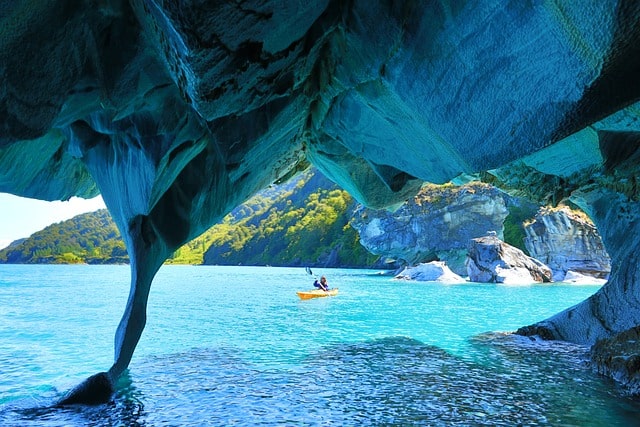Caves are perhaps one of the most unexplored and inhospitable environments on Earth. However, despite this seeming inaccessibility, explorers and adventurers continue to seek out and discover entirely new underground worlds all over the world. Some of the most interesting caves we know of are also unique, thriving ecosystems, home to a range of species with adaptations found nowhere else on Earth.
10. Marble Caves, Patagonia

The Marble Caves, estimated to be over 6,000 years old, are located on the Chilean side of Lake General Carrera in the Patagonia region of South America. Over the years, the lake's turquoise waters, enriched with calcium carbonate from nearby glaciers, gradually dissolved and eroded the underlying limestone bedrock, giving way to the intricate marble-like formations we see today.
In addition to their distinct marbled appearance, the lake’s striking blue hue, caused by suspended particles and reflecting sunlight, gives the entire site an otherworldly appearance, adding to its appeal to adventurers from around the world. However, access to the caves remains weather-dependent due to the rugged terrain and turbulent waters of General Carrera Lake.
9. Cave of Crystals, Mexico
Cuevade los Cristales , also known as the Cave of Crystals, was discovered in 2000 beneath the Sierra de Naica mountain in Chihuahua, Mexico. It was an accidental discovery made by a mining company during a routine excavation. The crystals are now known for their extraordinary size—some are nearly 40 feet long—as well as their unique, almost alien-like appearance.
As scientists later discovered, the crystals are made of gypsum, a hydrated calcium sulfate mineral formed by tens of thousands of years of volcanic activity beneath the Naica Mountains. This natural process is called hydrothermal mineralization, and as a result, the colossal gypsum crystals found in the cave today. Unfortunately, the extreme weather conditions inside the cave prevent casual travelers and researchers from regularly visiting them.
8. Ajanta Caves, India
The Ajanta Caves in India are a UNESCO World Heritage Site and are known for their unique rock-cut Buddhist cave temples. Situated in the Aurangabad district of Maharashtra, these ancient caves are believed to have been built between the 1st century BCE and the 7th century CE and are known for the frescoes on their walls and ceilings.
The Ajanta Caves were carved out of volcanic rock in a horseshoe-shaped gorge and consist primarily of 30 rock-cut shrines and monasteries that dot the picturesque mountainous landscape. Historically speaking, their construction can be divided into two distinct phases – from the Satavahana period between the 2nd century BCE and the 1st century CE to the second phase of the Vakataka dynasty between the 5th and 6th centuries CE.
7. Waitomo Glowworm Caves, New Zealand
The glowworm caves in the Waitomo region of New Zealand took over 30 million years to form. Named for the various species of bioluminescent worms that inhabit them, especially the native Arachnocampa luminosa, this unique natural structure continues to attract tourists and adventurers from all over the world.
The Waitomo Glowworm Caves were first mapped by local Maori chief Tane Tinorau, along with a British surveyor named Fred Mace. Visitors can explore the cave system on guided boat tours along the underground river that runs through the structure, and see thousands of glowworms lighting up the cave ceiling like a starry night sky.
6. Eisriesenwelt, Austria
Also known as the world's largest ice cave, Eisriesenwelt, which translates to "World of Ice Giants," is one of the most visited natural attractions in the Salzburg region of Austria. It's over 26 miles long, longer than most regular caves we know of, and its formation can be traced back at least 100 million years.
The cave system owes its existence to numerous natural processes, including water erosion and the natural movement of tectonic plates. Although it is popular with adventurers and caving enthusiasts from around the world, only the front portion of the cave is open to the public, with the rest consisting of over 25 miles of cold, mostly inaccessible caves and rooms. The entire structure remains cold throughout the year due to the cold winds outside, keeping the accessible portion intact and permanently frozen.
5. Kamchatka Ice Cave, Russia
The Kamchatka Ice Cave is one of many unique natural features found on the remote Kamchatka Peninsula in Russia's Far East. Formed by the freezing and melting of the region's vast glaciers, the cave is nearly 0.6 miles long and extends deep beneath the glacier like a natural arch of ice.
The formation of the cave can be explained by the dynamic interaction between glacial movements and the freezing temperatures of the region, which led to the creation of the unique subglacial chamber we see today. Due to volcanoes, the roof of the cave has melted to illuminate the chambers over the past few decades, giving the entire place an eerie atmosphere.
In addition to the cave, the Kamchatka Peninsula boasts many other unusual natural features, such as volcanoes, geysers, meadows, and snow-capped mountains. To experience the region in all its glory, the best time to visit is in the summer, when the weather is milder and the caves are available for exploration.
4. Blue Grotto, Italy
Blue Grotto, which means in Italian Grotta Azzurra, is a sea cave located on the island of Capri in southern Italy. Formed by the relentless erosion of the Tyrrhenian Sea, the cave is a popular, if rare, natural attraction on an island known for its high-end hotels and fashionable markets.
The Blue Grotto, located on the northern coast of Capri, is accessible by small boats that take visitors through a narrow entrance. However, the cave itself is quite large, measuring about 200 feet long, 80 feet wide and 490 feet deep. According to archaeological research conducted over the past few decades, the cave system is full of sculptures from Roman times, as we know that it was used as a private swimming pool during the reign of Emperor Tiberius.
3. Sac Actun System, Mexico
With a total length of over 200 miles and a maximum depth of over 390 feet, Sistema Sac Aktun is the longest underwater cave on Earth. Located along the Caribbean coast of Mexico’s Yucatan Peninsula, it is part of one of the most extensive underwater cave systems we know of. To date, more than 220 cenotes, or sinkholes, have been discovered along its length, most of which were formed by the collapse of the cave’s ceiling.
Exploration of the region began in 1987, when various teams of divers and other specialists began mapping the network of caves found in the state of Quintana Roo. The Sac Actun system, also known as the "white cave," is now known for its size and the diversity of flora and fauna found in its many ecosystems.
2. Mammoth Cave System, USA
The Mammoth Cave system can be found in Mammoth Cave National Park in Kentucky. At about 350 miles long, it is the longest known cave system in the world, with many of its caves and sections still hidden and unexplored.
Formed over millions of years by underground rivers dissolving limestone, the cave system is home to a complex network of chambers, tunnels, and passages with visually stunning stalactite and stalagmite formations in odd locations. Unlike some of the other caves on this list, people have known about Mammoth Caves for a long time, as there is evidence that they were used and explored by Native Americans.
Due to its historical and natural significance, as the caves are also home to a number of endangered plant and animal species, the Mammoth Cave system has been classified as a UNESCO World Heritage Site.
1. Son Dung, Vietnam
Son Doong is a large, famous cave located in Quang Binh Province in central Vietnam. At about 650 feet tall and about 500 feet wide in some places, it is the largest known cave in the world by volume. As researchers have discovered since its discovery in 2009, Son Doong is only a small part of a vast, much larger cave system in the region, about 70% of which remains completely unexplored.
The cave was discovered by chance in 1990 by a local named Ho Khanh, although it wasn’t until 2009 that it was fully explored by a team of scientific experts. According to research, Son Doong took millions of years to form, with slow, gradual erosion of the limestone giving way to the vast cavern we see today. However, the structure’s inaccessibility makes any long-term scientific exploration impossible—any entry or exit into Son Doong requires a vertical climb or descent of at least 280 feet.













Оставить Комментарий